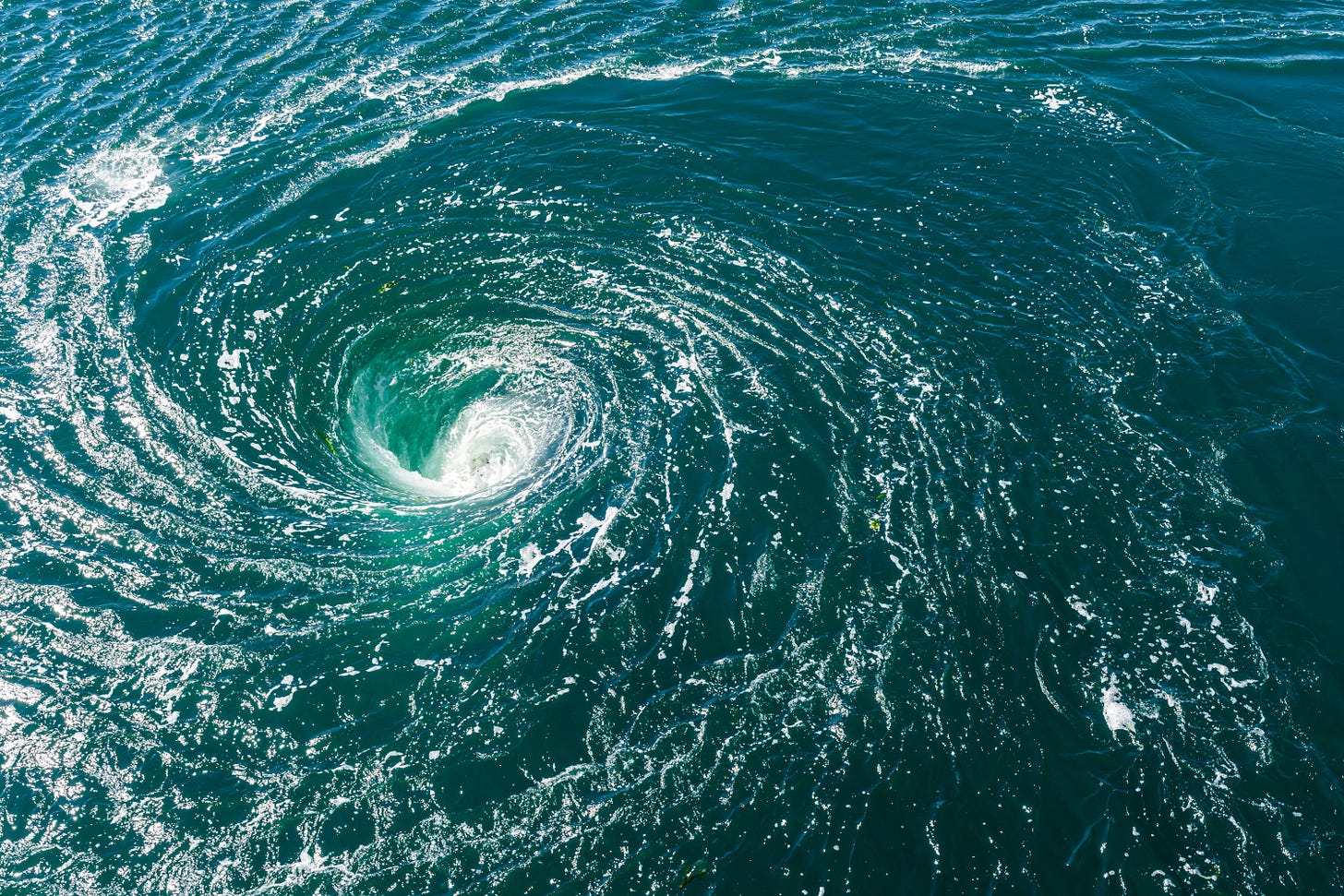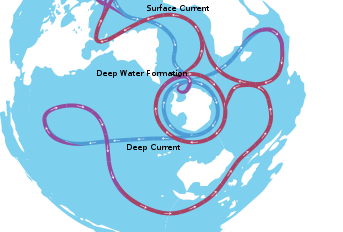Antarctic Ocean Currents Threaten "The Day After Tomorrow"
Oceans currents are slowing. That's trouble. If they stop, Earth may not recover for 1,000 years.
EDITOR’S NOTE: Ahead of our update this week on the state of the AMOC—the Atlantic MeridIonal Ocean Circulation—and its threatened collapse by 2025, we are restacking our article on the Antarctic Ocean Currents, which work with the AMOC to keep earth’s climate temperate. They’re in trouble. It is incredibly important that these facts not remain the province of science alone and that citizens inform themselves.
They are, truly, the stuff of myth and legend. Odysseus, on his journey home, encountered the monster Charybdis, whose great thirst for the sea thrice a day created a great maelstrom that consumed men and ships. Now we place this maelstrom near Messina and Scilla in the narrow strait between Italy and Sicily. It is this whirlpool in this place that proved so threatening to seafarers that it appeared not only in The Odyssey but also in the myths of Jason and the Argonauts and in the stories of the Trojan Aeneas.
But it was not these Mediterranean sea spinners that captivated earth scientists in 1970. It was the spinning of the North Atlantic maelstroms—seven huge whirlpools in the Greenland and Norwegian Seas called chimneys—that would lead to a stunning revelation filled with wonders and fears. The chimneys, scientists learned, were a part of an ocean turbine system—the northern part. The southern part is the current that circles the globe while while it circles Antarctica.
Together these currents run a global “conveyor belt” of ocean water that both cools and warms the planet—releasing excess heat near the Arctic Circle while simultaneously warding off the next ice age by keeping the world warm enough that it doesn’t freeze.
Worldwide, north and south, the circulation of the seas is slowing down. That’s trouble.
First let’s look at the whole world. This image, by German physicist Stefan Rahmstorf, shows the planet’s major ocean currents, which, combined are called Global Thermohaline Circulation. Thermo means “heat,” and saline means “salt.” The whole system runs on the density of the water that is provided by the salt (which makes it heavy) and differences in water temperature. More on that in a minute.
In this image the red flows are warm water near the oceans’ surfaces—and blue and purple lines are cold, deep waters. But the real stars of this show are the four yellow ovals—two in the extreme north and two in the extreme south. Those are the chimneys—the maelstroms that are the turbines that keep the water moving worldwide.
Where these yellow ovals are, the currents release the heat they’ve picked up traveling on the surfaces. Now, of course, they’re very near the poles, and it’s cold. Some of the water is taken up as ice—but its salts are left behind. Salt doesn’t freeze, so all the ice is made up of pure H2O (fresh water) with its salt discarded. Now all the fluid water is super-saturated with salt, making it incredibly heavy, and this dense, heavy, cold water falls by its own weight.
The chimneys begin to spin, swirling down almost two miles to the ocean floor. The water is incredibly cold. The chimneys “flip” the water in the seas—and are known as Meridional Overturning Circulations.
Now the water travels in the deep canyons near the ocean floor, but eventually it rises due to the shape of undersea terrain. Now, exposed to the sun and its salts diluted by fresher water at the surface, the currents warm. Having made a trip from the North Atlantic virtually all around the world, their last detour before heading back to the North Atlantic—a quick trip to the Gulf of Mexico—means the water arriving in the Greenland and Norwegian Seas is very warm. But here, again, the water meets the Arctic cold, its freshwater is taken up in ice (at least at some times of the year), and the remaining water, now cold and dense and salty, plunges again to the ocean floor.
So, these are the four chimneys. But they are not all created equal: it’s the sea around Antarctica that’s really running the show. It is the strongest current on earth and flows clockwise.
Double-click on the replay link below for a moving image of the Antarctica Circumpolar Current (ACC) for the last few years.
Video Credit: Alfred Wegener Institute, Helmholtz Centre for Polar and Marine Research.
The Antarctic current looks as if its flow is self-contained, that all of it is just going ‘round and ‘round in a circle. Much of it is—but not all of it.
Looking at the world from the south, you can see the circular current around the South Pole—and also how it feeds into and pushes global ocean current circulation—in three oceans.
What happens if the ACC Slows Down?
Rising global temperature, caused by carbon emissions, is melting ice caps, pouring massive quantities of fresh water into the oceans. New scientific modelling by MIT, Australian National University, and the University of New South Wales indicates that more fresh water could slow down deep water circulation more than 40 per cent by 2050 – putting it on a path towards collapse.
“Our study shows that the melting of the ice sheets has a dramatic impact on the overturning circulation that regulates Earth’s climate,” says Dr. Adele Morrison, from ACEAS and the ANU Research School of Earth Sciences.
With collapse of the deep current, oceans below 13,000 feet (4,000 meters) would stagnate and cause impacts for centuries, trapping nutrients in the deep ocean away from marine life near the surface. It would decimate sea life as we know it.
And it could trigger a new ice age. Hence the hyperbole about The Day After Tomorrow.
The new study’s scientific modeling is based on a “high emissions scenario” that is all too likely to continue. The melting of the polar ice sheets and the collapse of Antarctic ice shelves is expected to accelerate as the planet heats up.
What Happens If Overturning Stops at Both Poles? Maybe Another Younger Dryas Period.
The Younger Dryas was a cool period between roughly 12,900 and 11,600 years ago that interrupted the warming trend in t he Northern Hemisphere at the end of the last ice age. It was a sudden, devastating climate shift. Its onset took less than 100 years, and it lasted thirteen centuries. It returned large parts of the Northern Hemisphere to ice age conditions.
So what happened?
At the end of the last ice age, the glacier over North America, the Laurentide Ice Sheet, started melting and retreating. It left behind a huge inland sea called Lake Agassiz that covered a large part of north-central North America. Rather than draining into the Mississippi River, its waters flowed into the North Atlantic in the area that is now the St. Lawrence Seaway.
As the fresh water diluted the salinity of the northern oceans, the chimneys shut down. The turbines no longer turned. There were no maelstroms to carry the cold water to the sea floor.
Global Thermohaline Circulation, at least in the North Atlantic and possibly worldwide, shut down for 1,300 years. The result was a mini-ice age in the northern climes and a slight warming in the Southern Hemisphere. Populations, human and animal, in the northern latitudes were decimated, with widespread starvation in Greenland and Iceland. Flora species changed dramatically all over Europe and North America. Populations at mid-latitudes began to become more nomadic, following food supplies.
When the salinity-density of North Atlantic waters recovered and the Atlantic Meridional Overturning Circulation of the chimneys began to spin again, the Younger Dryas ended even more rapidly than it began, with warming to previous temperatures taking as little as 10 months.
If a Younger Dryas were to happen now, with populations packed tightly into urban centers with millions of people, it could kill billions of people as well as destroying unimaginable resources in flora and fauna. Mechanical and digital technologies would grind to a halt.
Both the Antarctic Circumpolar Circulation and the Global Thermohaline Circulation are slowing down. Of particular concern is the one at the bottom of the world, which has so much impact on the sea circulations of three oceans and such power to stop the flow of the nutrients that sustain sea life.
Scientists are desperately calling for immediate action to severely limit carbon emissions and to sequester as much of what is already in the atmosphere as we can.
It isn’t like scientists to be melodramatic. In invoking The Day After Tomorrow, they are sounding an alarm they feel must be heard. We are running out of time.





Thank you for this vivid, easy-to-understand and impossible to ignore explanation of what is happening and its consequences. It is shocking and appalling that this HAS BEEN KNOWN AND IGNORED by others who have been in a position to take action. We have been doomed by their greed and ALL of our laziness, selfishness and procrastination. If there is any justice, the human race will not survive.
Now here's a thought. IF the global thermo-haline conveyor shut down, producing a new Younger Dryas event, one of the consequences would unquestionably be a massive migration event. But this one would be quite different. It would be composed of people from northern Eurasia migrating southwards.